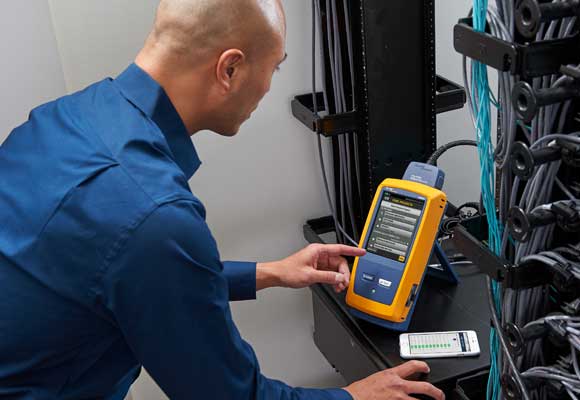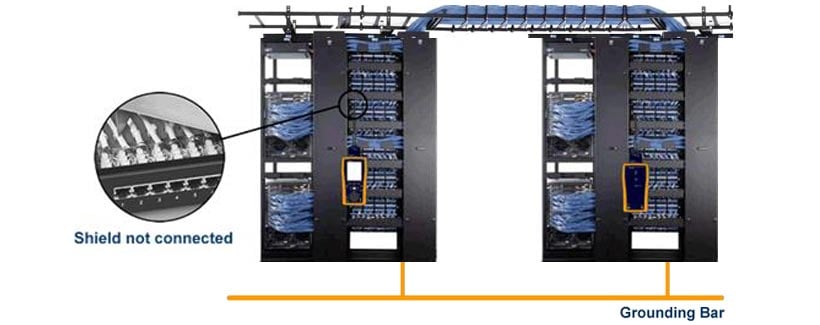WHITE PAPER
Fluke Networks Shield Integrity
Download PDF
Overview
Field testing of screened cabling systems has always required that the tester verify that there is continuity of the screen to the remote end of the test, however some field testers can incorrectly report screen continuity and fail to highlight potential problems with the cabling system.
This article discusses the issues with measurements of screen continuity, how it can influence other cabling test parameters and how the Fluke Networks shield integrity approach can correctly assure compliance of cabling installations according to the Level 2G requirements of TIA 1152A.

On This Page
Screen Continuity Path
Continuity of the screen is often thought of as a simple electrical connection between the screen contacts of the near end and remote testers. However there are 3 main paths through which this can occur yet only one of those paths assures correctly terminated cabling that will allow the cable to function the way it is designed to.
Figure 1 shows a permanent link in which the shield is not connected to the cable, but has an electrical connection to the remote tester by the path through the panels, racks and building grounding bar. In this case some field testers may report screen correct continuity, even when the cabling screen is open circuit.

Figure 1 – Screen path through building ground
Figure 2 shows another example of where a tester may report screen continuity is correct when it is actually open circuit. In this case the far end rack is not connected through the building ground, however another link with a correctly terminated shield runs between the same racks and provides a screen continuity path for the link with the open circuit screen.

Figure 2 – Screen path through another compliant link
These incorrect results are unavoidable using some testers, however DSX 5000/8000 CableAnalyzers™ can detect these situations and will only report the screen continuity of the cabling under test. This allows the user to be confident that the screen connection of the link or channel under test can perform to the intended transmission performance.
Screen continuity and alien crosstalk
Screened cabling systems achieve extremely high levels of alien crosstalk performance using not only well balanced cable designs, but also by inclusion of a metallic foil element which acts as a Faraday cage intercepting any coupling from the pairs within before it reaches any other cables. For this to work most effectively, the signal coupled onto the shield should be conducted away to ground through the cable screen into the screen of the connector, the panel, and from there to the building ground. Should any of this path be open circuit, then the screen may be floating ground, which degrades the isolation and hence increases alien crosstalk. This effect can be large, in some cases degrading alien crosstalk by over 15dB.
Proper screen grounding is also of vital importance to other parameters such as NEXT and FEXT, and is of particular importance to systems which use shielding techniques to minimize crosstalk between pairs, such as Class FA and Class II cabling.
By combining traditional DC continuity methods with shield integrity techniques, the Fluke Networks DSX 5000/8000 CableAnalyzer is able to correctly identify open circuits caused by building grounds or other compliant cabling and hence help ensure that the cabling can provide complaint alien crosstalk and 10/25/40Gb application support. These methods can also pinpoint the distance to the shield fault, greatly reducing troubleshooting time in the case of an open screen.
Standards compliance
Testing of the screen continuity has always been specified by the field tester standards TIA 1152 and IEC 61935-1, however no guidance was given to specify the path through which that continuity was provided.
For the first time, this has been addressed in TIA 1152A, which provides a clarification of this screen testing requirement for level 2G testers which must be used to test Category 8 cabling.
“In addition, for Level 2G testers it is understood that the screen continuity is tested along the path of the cabling”
– TIA 1152A Clause 4.2.2
Given that many level V and below testers did not comply to this understanding, this only applies to level 2G testers for Category 8, further highlighting the importance of screen connection and alien crosstalk on Category 8 applications.
Fluke Networks not only complies with this requirement on the Level 2G DSX 8000 for all categories up to TIA category 8 and ISO/IEC Class II, but also on the level V DSX 5000 covering all categories up to TIA Class EA and ISO/IEC Class FA.
Difference between DTX and DSX series testers
Applying shield integrity techniques to the screen continuity measurements is standard on the DSX 5000/8000 CableAnalyzer. The DTX CableAnalyzer and some other manufacturers of cable testers rely on basic continuity measurement techniques which can result in incorrect results as shown in Table 1.
| Open Shield in Tested Cabling | Building Ground Connection | Secondary Compliant Link Connection | DTX/Other Screen Continuity Result | DSX Screen Continuity Result | Correct Result |
|---|---|---|---|---|---|
| No | No | No | ✓ | ✓ | DTX & DSX |
| No | No | Yes | ✓ | ✓ | |
| No | Yes | No | ✓ | ✓ | |
| No | Yes | Yes | ✓ | ✓ | |
| Yes | Yes | No | ✓ | X | Only DSX |
| Yes | No | Yes | ✓ | X | |
| Yes | Yes | Yes | ✓ | X | |
| Yes | No | No | X | X | DTX & DSX |
Table 1 – DSX and DTX screen test results
Conclusions
Correct termination of the screen of the cabling is vital to achieving the system performance of the cabling particularly with regard to alien crosstalk and internal crosstalk parameters, and not all cabling test equipment can identify open circuits when installed with other cabling or building ground paths connected to the remote tester.
The Fluke Networks DSX 5000 and DSX 8000 CableAnalyzers correctly test along the path to the cabling according to TIA 1152A Level 2G requirements and detect the distance to fault for faster troubleshooting.
For additional information and updates, follow Fluke Networks on social media.
Twitter: https://twitter.com/flukenetdci
Facebook: http://www.facebook.com/flukenetworks
LinkedIn: http://www.linkedin.com/company/fluke-networks




